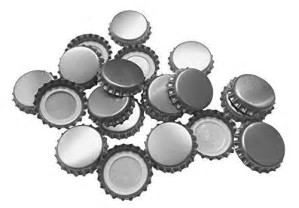How does keeping a carbonated beverage capped help keep it from going "flat"?
1 Answer
The cap on a carbonated beer or soft-drink is GAS TIGHT......and prevents the passage of gas out from the bottle, and out of solution.
Explanation:
Typically, when we bottle beer or ginger beer (for instance) just before capping the bottle we would put a teaspoon or so of sugar in the bottle with the beer, so that the sugar undergoes fermentation in the bottle with residual yeast to form a little bit of ethanol, and also carbon dioxide. The carbon dioxide thus
The bottle is thus pressurized to
If you are doing A levels you should ask your chem teacher (nicely!) if you can brew home brew (beer or ginger beer) in the laboratory. This is fairly simple to do but needs a bit of organizing; the teachers will certainly appreciate your efforts, because after a few weeks they can drink all the beer that you have made.

The picture depicts the crown seals that you typically put on the bottle with a capper; I think you can see the neoprene ring on the inside of the cap, which forms a gas-tight seal with the bottle opening to trap the gas that evolves.

